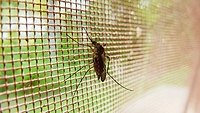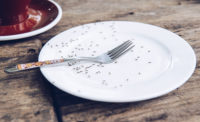Common Pests in Restaurants and How to Deal With Them—Part 1

Credit: Henryphoto via Pixabay
Restaurants are a paradise for pests because they provide everything pests need: food, water, and shelter. Pest infestations in restaurants have been repeatedly linked to foodborne illness outbreaks. Pests are a major source of concern for restaurant operators because they put food safety at risk by transmitting disease-causing pathogens and contaminating food. Pest infestations can have a significant financial impact on a restaurant, resulting in revenue loss, higher treatment costs, loss of customer confidence, and food waste.
This two-part article series considers some common restaurant pests, as well as preventive measures restaurant owners can take to avoid infestation. It also examines chemical and non-chemical treatment options available to restaurant operators for controlling or eliminating an existing infestation.
Flies
The most common types of flies that infiltrate restaurants are fruit flies, drain flies, and house flies. Fruit flies measure about 3 mm in length, are brownish-yellow to brownish-black in color, and live for 8–15 days. Drain flies, on the other hand, are gray to brown in color, measure 1.5 mm–5 mm in length, and live for about two weeks. House flies are 6 mm–7 mm in size, have a lifespan of 15–30 days, and are ash gray to black in color. These flies thrive in temperatures ranging from 75 °F–100 °F (24 °C–38 °C), and their population explodes during the summer.
Flies do not chew; instead, they feed by sucking fluids and the liquids from soft food. Since they feed on liquid food, they leave feces wherever they land, increasing the risk of contamination of food, surfaces, and kitchen equipment. Flies hunt for food during the day and are inactive at night. They spread bacteria, fungi, and viruses from one surface to another and are known to carry a variety of pathogens such as Salmonella and E. coli, and transmit diseases like typhoid fever, diarrhea, cholera, and dysentery. A fly's lifecycle begins with the laying of eggs, which develop into larvae (also called maggots) and then pupae, which can mature into adults in as little as seven days. Flies lay their eggs in moist environments like pools of water, trash, and decaying organic material like fruits and vegetables, and they thrive in hot, humid environments like restaurant kitchens.
Flies enter the restaurant through open doors, exhaust vents, and gaps in windows and doors. They are drawn to food odors produced by commercial kitchens, which are caused by food waste such as rotting vegetables and fruit, as well as kitchen trash. Outside of a restaurant, flies seek refuge in plants, electrical fixtures, and dumpsters. Once inside of the restaurant, they rest on floors, walls, and ceilings. Once an infestation has been established inside of a restaurant, flies can live for up to a month depending on the species.
Signs of Infestation
Restaurant operators must be on the lookout for signs of fly infestation so that appropriate measures can be taken to eliminate it. Some indicators of fly infestation include:
- A strong odor in the restaurant kitchen that smells like decaying vegetables and meat
- Regular sighting of flies in the kitchen, service areas, or around trash receptacles/dumpsters
- The presence of small, dark clusters of fly feces that appear as black dots
- The presence of maggots in the kitchen or service areas.
Hot Spots for Flies
Some of the hot spots that attract flies include:
- Food debris accumulating in and around sinks, floor drains, and at the intersections of floors and walls, as well as on floors and around floor drains
- Spills or splashes of syrupy liquids (e.g., juices) on floors and walls that go uncleaned for an extended time
- Soiled garbage bins that are not cleaned on a regular basis and are left uncovered
- Food items left out in the open, uncovered
- Dirty dishes left in the sink for an extended period of time
- Water pooling on floors, as well as at drainage and water intersections.
Measures to Prevent Fly Infestation
To prevent fly infestation, it is critical to evaluate the restaurant's interior and exterior. Some preventive measures include:
- Plant trees 8–15 feet away and shrubs at least three feet away from the restaurant building
- Install self-closing doors and air curtains, and screen exhaust vents, doors, and windows
- Keep food refrigerated when not in use, or store in properly closed containers
- Wash soiled dishes right away and do not allow them to build up in the sink
- Immediately clean up food and drink spills on the floors and walls
- Keep drains, as well as floor and wall intersections, free of food debris accumulation
- Keep a minimum of 30 meters (around 100 feet) of space between the kitchen and the trash disposal area
- Rinse out cans, bottles, and plastic whenever possible before discarding them
- Empty and clean dumpsters on a regular basis and keep areas around dumpsters clean.
Non-Chemical and Chemical Treatments
Depending on the severity of the infestation, restaurant operators can use chemical treatments, non-chemical treatments, or a combination of both. A flash fly killer is a non-chemical treatment available to restaurant operators. When installing a flash fly killer, the position and height must be carefully considered. It must be installed at the point of "interception"—i.e., somewhere between the primary point of fly entry (usually the back door or windows of the restaurant kitchen) and the food preparation area. It is critical to note that in restaurants, flies are more likely to enter through the back door rather than the front door because the kitchen trash and dumpsters are kept near the back door. The flash fly killer must be mounted five feet above the floor at the point of interception.
Many chemical treatments are available to control fly infestation. Fly bait is one such treatment. Fly bait uses an attract-and-kill strategy to kill flies. It contains sugar-based feed laced with spinosad (an insecticide that attracts flies and is fatal once swallowed). Spinosad is a naturally occurring chemical produced by soil bacteria that is harmful to flies. Insecticide sprays are another chemical treatment option that restaurant operators might consider. These sprays contain pyrethroid, which, when inhaled, affects the neurological activity of flies, resulting in their death.
Cockroaches
Cockroaches are more common in foodservice establishments than flies. The most prevalent cockroaches are American Cockroaches, Brown-Banded Cockroaches, and German Cockroaches. American Cockroaches are 34 mm–55 mm long, reddish-brown in color, and have a one-year lifespan. Brown-Banded Cockroaches are light brown to dark brown in color, 10 mm–14 mm long, and live for about 200 days. German Cockroaches live for 20–30 weeks, are light brown in color, and are 13 mm–16 mm long. These cockroaches prefer breeding in dark and moist environments, and their activity begins shortly before midnight. Temperatures between 59 °F and 84 °F (15 °C and 29 °C) are optimal for their reproduction and colonization. The cockroach lifecycle involves egg laying, development into nymphs, and maturation into adults in about 150 days.
Once a colony is established, cockroaches are difficult to control for two reasons. First, they reproduce quickly, and second, female cockroaches can lay a large number of eggs. Cockroaches carry a wide range of diseases in their urine, droppings, and saliva, and are known to contaminate equipment, utensils, and food contact surfaces. They have been linked to the spread of diseases such as salmonellosis, typhoid fever, cholera, plague, and leprosy. Worse, cockroach feces contain a pheromone that attracts more cockroaches. These insects have sticky pads on their feet and can easily scale flat surfaces, such as glass. Cockroaches shed their exoskeletons multiple times during their maturation cycle from nymph to adult, and the exoskeleton shedding or feces of the insects in food preparation areas increases the danger of food contamination.
The most typical way cockroaches enter restaurants is through incoming supplies, delivery vehicles, openings in exhaust vents, and plumbing lines. They also infiltrate through cracks and crevices in doors and windows. Cockroaches, like flies, are attracted to odors emitted by food, septic systems, and decomposing waste. Once inside of the foodservice establishment, cockroaches often take up residence inside garbage cans, storage cupboards, electrical appliances, and exhaust vents. They can also be found hiding inside sinks, drains, and pipelines, as well as beneath gas ranges, cracked tiles, and furniture.
Signs of Infestation
The following are some signs of cockroach infestation:
- Droppings that are black and dusty and look like coffee grinds
- Unpleasant, intense, musty smell
- Signs of damage on food packaging
- Sighting of live cockroaches at night
- Fecal droppings in storage cabinets, around sink areas, and inside cooking equipment.
Hot Spots for Cockroaches
Some of the hot spots for cockroaches in restaurants include:
- Leaky pipes and broken plumbing fixtures
- Piles of paperboard cartons and sagging spots in storage areas
- Storage drawers with buildup food debris
- Areas under sinks, furniture, or inside cooking equipment such as ovens and microwaves.
Measures to Prevent Cockroach Infestation
It is critical to inspect both the inside and outside of the restaurant to avoid cockroach infestation. Some measures to prevent an infestation are listed below:
- Keep the exterior and surrounding perimeter clean and clear of dirt and litter
- Keep windows and doors closed, and install screens
- Repair worn-out structures, such as broken walls, flooring, and tiles. Cockroaches frequently hide in crevices and holes in walls and doors; therefore, they must be sealed with a caulking agent
- Hire an exterminator, identify potential entry sites, and inspect them on a regular basis
- Store food in tight-fitting containers, and never leave it out in the open
- Sweep and mop floors on a regular basis
- Keep storage areas clear of cardboard, newspaper, and other clutter
- Immediately clean up all food and drink spills
- Keep the kitchen sinks and drains clean
- Maintain a safe distance between the kitchen and the garbage storage or disposal areas
- Always rinse out cans, bottles, and plastic packaging before discarding them
- Empty and wash waste bins on a regular basis
- Keep dumpsters clean, and wash them on a regular basis.
Non-Chemical and Chemical Treatments
One non-chemical cockroach control approach is heat treatment, which involves the use of heat exchangers in the treatment area. Liquid syrup is delivered to the heat exchangers via insulated pipes, and the area is heated to 140 °F–150 °F (60 °C– 66 °C) for five to six hours. This treatment not only kills the cockroaches, but also denatures their fecal matter. Another non-chemical option that can be used in infested areas of the kitchen or dining room are glue traps. However, they have several limitations, such as only trapping a small number of cockroaches and being ineffective when the infestation is severe.
Gel bait solution is a chemical treatment option available to restaurant operators for cockroach control. It contains the insecticide indoxacarb and has a pleasant odor. The odor attracts cockroaches, which mistake it for food and swallow the gel bait, which subsequently dehydrates and kills them. Insecticide sprays, which contain pesticides such as synthetic pyrethrins and pyrethroids, are other chemical treatments available to combat cockroach infestation. These insecticides permeate the skin of the cockroaches and disrupt their neurological function, resulting in paralysis and death. Foggers or bug bombs, which work in a similar way to pesticide sprays, are additional options for controlling cockroach infestation.
Ants
Ants are one of the most common pests seen in restaurants. One of the main reasons for this is because they can get in through even the smallest gaps or crevices. The most common ants seen in foodservice establishments are Odorous House Ants, Pavement Ants, Carpenter Ants, and Pharaoh Ants. Odorous House Ants are 2.4 mm–3 mm long, brown to black in color, and have a lifespan of two to three years. Pavement Ants are 2.5 mm–3 mm in size, dark brown to black in color, and live for about five years. Carpenter Ants are dull black in color, measure 9.5 mm–12 mm in length, and live for 7–10 years, on average. Pharaoh Ants are about 2 mm long, light yellow to reddish-brown in color, and have a lifespan of 4–12 months.
The lifecycle of an ant begins with laying eggs, which hatch into larvae and then become pupae before emerging as adults in a matter of weeks to months, depending on the species. Some ants are nocturnal while others are not, and some forage for food around the clock. Ants feed on water; sugary, soft foods; fresh produce; and dead insects. They thrive in areas with significant moisture and stagnant water. Ants prefer dark, quiet environments, so they build their nests in holes, fractures, and crevices in walls, floors, and fixtures in kitchens and service areas. They can carry various harmful pathogens and transfer them to equipment, food, and surfaces, causing E. coli, Shigella, and Salmonella infections. Ants produce pheromones, which attracts other ants to a food source.
Signs of Infestation
Some of the signs of an ant infestation are:
- Regular sightings of ants in large numbers
- The presence of ant colonies (resembling clumps of dirt or soil) on floors or other areas.
Hot Spots for Ants
Some of the hot spots that attracts ants in restaurants include:
- Structural damage in floors and walls, such as cracks and holes
- Spilled food on floors that is not cleaned up
- Poorly mounted kitchen equipment without any space for cleaning access
- Food left outside or uncovered for an extended period of time.
Measures to Prevent Ant Infestation
An ant infestation can be difficult to eradicate and can spread throughout the entire restaurant. Preventative measures are the best alternative for avoiding an ant infestation:
- Immediately clean food spills or splashes
- Sweep the floors in the kitchen and dining areas on a daily basis to keep them clean and free of dirt and debris
- Clean the areas behind cooking equipment, behind gas ranges, and around furniture on a daily basis
- Repair or replace cracked tiles on floors and walls, as needed. With a caulking agent, fill all gaps and holes in the floors and walls
- Fix leaking faucets and plumbing leaks
- Keep the restaurant's exterior clean and free of debris
- Store food in airtight containers
- Clean the kitchen and service areas before leaving for the day, including food contact surfaces, the floor, the walls, floor mats, storage cabinets, and cooking appliances.
- The kitchen and service areas must be deep-cleaned regularly to keep them free of grease, dirt, and food debris
- Wash and sanitize cutting boards as needed between usage, and wash and dry-stack them before leaving for the night
- Rinse out cans, bottles, and plastic packaging before discarding them
- Cruet sets, ketchup bottles, and places in and around the sideboard must always be kept clean
- Empty and wash garbage cans before leaving for the day.
Non-Chemical and Chemical Treatments
A non-chemical method to kill ants includes wiping away ants with a soapy water solution. Another option is to use citrus-based cleaning solutions, which kill ants while also removing ant pheromones, which attract more ants to the food source. D-limonene, an acidic oil that is harmful to ants, is an active element in citrus-based cleaning solutions.
Sprays and gels are effective chemical treatment options for controlling ant infestation. Imidacloprid, clothianidin, acetamiprid, or thiamethoxam are the active components of these sprays and gels. They are sprayed or applied at the infestation site or at the intersections of walls and floors. Ant sprays disrupt the neurological systems of the ants, causing paralysis and death.
Part 2 of this article series, to be published in the June 28th eDigest, will examine methods for addressing and preventing infestations by rodents, stored product insects, and mosquitoes.
Looking for a reprint of this article?
From high-res PDFs to custom plaques, order your copy today!







